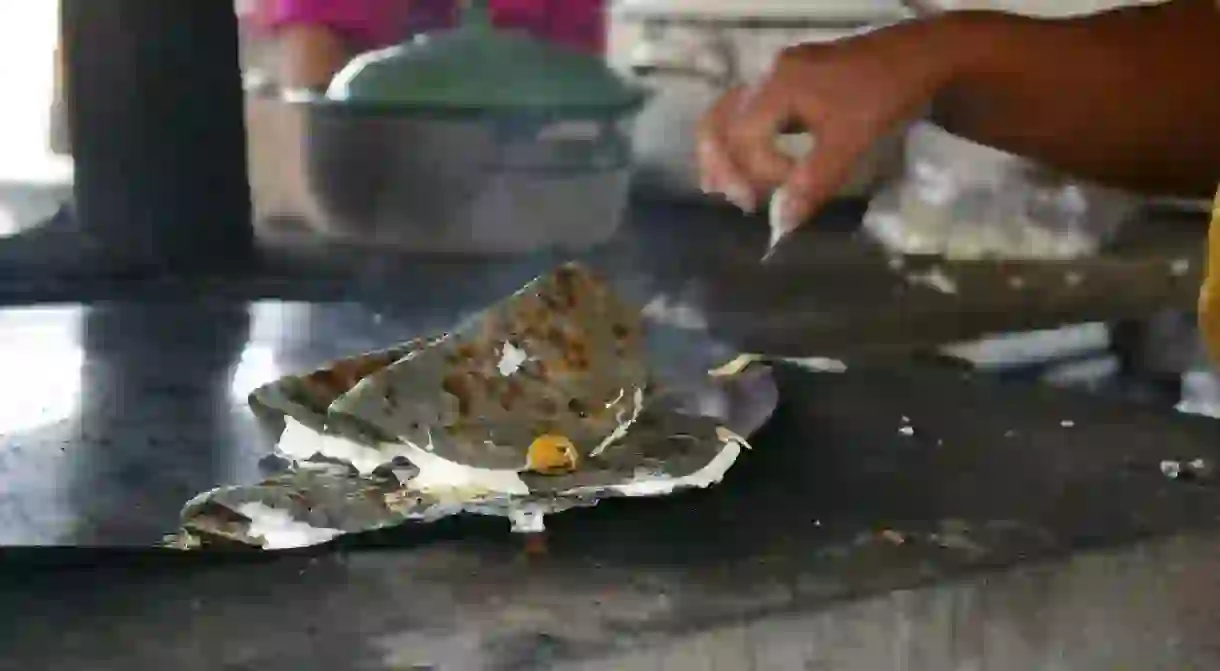What to Order at a Mexico City Quesadilla Stand

Quesadillas are quintessential Mexican street food and in Mexico City, surviving on quesadillas alone wouldn’t be too tough: you could have one with squash blossoms and cheese for breakfast, a hearty potato and sausage quesadilla for lunch, and a couple of deep-fried quesadillas in the evening with an ice cold beer to call it a day. If you happen to be new to the quesadilla world, we’ve got everything you need to know when it comes to hitting Mexico City’s street food stands.
Just the facts
First, it’s important to know that while most of the country’s quesadillas are filled with cheese, that’s not the case in Mexico City. If you want a cheese quesadilla, you’ll have to specify when ordering. The quesadillas made in Mexico’s capital are generally made of large, football-shaped tortillas (of either blue or yellow corn) that are wrapped around various fillings which vary from one stand to the next.

You will recognize these stands because the are usually run by two or three women: one makes the tortillas by flattening out tlacoyos (more about those later), one mans the large, circular grill called a comal, and one handles the money and takes orders from customers. Because quesadillas are eaten during the day more than they are at night, you’ll see that most stands operate during the day though there are some stands that sell into the evening.

Etiquette
As with most street food, there is an unspoken etiquette for eating at quesadilla stands. The first and foremost rule is to say “provecho” to those who are already eating when you arrive (provecho is Mexico’s bon appétit). You’ll either need to stand or sit and wait until one of the vendors asks what you would like to order, which will include specifying whether you want your quesadilla to stay or to go. Para ir comiendo means that you want to eat it while you walk, so instead of wrapping up your food inside a plastic bag and sealing it up, the vendor will simply put your order on a disposible plate for you.
You can always ask the vendors what they have for the day’s rellenos (fillings), but a series of containers will generally be out in the open for diners to survey and choose from.

Fill ’em up
This is a basic list of fillings that can be found at quesadilla stands, which is by no means meant to be exhuastive. Hopefully, you’ll find a filling that’s not on this list and be bold enough to try it!
Flor de calabaza: Squash blossoms that are grilled on the comal for a few minutes before being mixed with cheese and stuffed into a tortilla
Papa con chorizo: Potato mixed with Spanish-style chorizo sausage
Papa con longaniza: Potato with spicy Mexican-style sausage
Longaniza by itself: Spicy Mexican sausage that can be quite greasy and is best when grilled until it has a little crunch
Rajas con crema: Strips of poblano peppers mixed with cream (sometimes with the addition of corn kernels)
Chicken or beef tinga: Shredded meat cooked with onions in a tomato-based sauce that is generally not spicy
Huitlacoche: A salty black and grey edible fungus that grows on corn (called corn smut in English)
Chicharrón: Pieces of fried pig skins and rinds that are usually mixed with a tangy green sauce
Champiñones: Pre-cooked and seasoned button mushrooms that are also sometimes called hongos or setas and can include oyster mushrooms
You can get any of these fillings, and many more, with cheese or solo (without any cheese).

A word on salsas
Sometimes you’ll be asked which salsa you want (red or green) and the person making your quesadilla will either add it for you or let you do it yourself. Don’t be shy about asking which salsa is spicier even if you get an eye-roll reply and an answer saying that both salsas are equally spicy. The best way to handle this spicy situation if you haven’t frequented a particular stand much and familiarized yourself with its salsas is to ask for a small amount (poquito) or put the salsa on your quesadilla yourself to try it first. Remember—you can always add more.

Other delights
Many quesadilla stands sell other things like tlacoyos or gorditas. Tlacoyos are smaller, football-shaped corn dough patties filled with cooked and ground fava beans, refried beans, or requesón cheese (which is similiar in consistency and taste to Italian ricotta). The patties are then heated on the grill and topped with raw chopped onions, cilantro, shredded Nopal cactus, grated queso fresco (similiar to mozarella but with a harder consistency), and either red or green salsa.
Other stands sell gorditas, which may have chicharrón prensado (fried and pressed pig skin and bits of meat) blended in with the dough to make them slightly greasy and meaty. Gorditas are circular, thick, and cut into a pocket that’s filled with any of the fillings mentioned above but most traditionally with fresh Nopal cactus and queso fresco.














